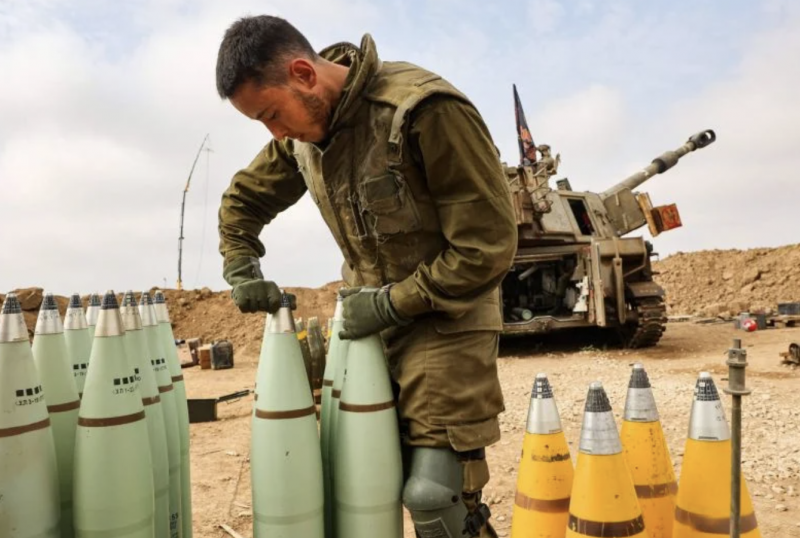
An Israeli artillery unit near the border with the Gaza Strip, Dec. 5. (Credit: Gil Cohen-Magen/AFP)
With the war resuming in Gaza following a week-long truce, the Kfir brigade, which usually operates in the West Bank to combat “Palestinian terrorism,” entered the Palestinian enclave for the first time, carrying out its first ground maneuver in a war zone.
What is the Kfir Brigade and what is it doing in Gaza?
Kfir Brigade is the largest of Israel’s five infantry brigades, “at the forefront of the war against Palestinian terrorism,” according to the army’s website. Operating under the central command, this brigade, whose name means the Lion Club Brigade, is made up of five battalions stationed in the occupied West Bank, from Hebron in the south to Jenin in the north, via Tulkarem.
The 900th Brigade was established in 2005 “in response to the need to combat Palestinian terror in the Judea and Samaria,” said the Israeli forces’ website, in reference to the biblical name used by Israel to designate the occupied territories. These units specialize in urban guerrilla warfare in dense areas and complex operations.
“The brigade’s combat team in Gaza consists of its Haruv reconnaissance unit and 94th Duchifat Battalion, alongside reservist tank forces from the Kiryati Brigade, combat engineers and artillery forces,” Times of Israel reported.
According to the Israeli army, until Dec.4, the brigade helped to locate and destroy more than 30 entrances to tunnels in Gaza suspected of being used by Hamas to move, shield, launch operations, train or manufacture weapons. The brigade also launched nearly 100 artillery strikes and destroyed numerous targets of the Islamist movement, the army said in a press release.
Objectives in the South?
As with the other soldiers on the ground, there appears to be close cooperation with the air force. While it is not clear in which zone the brigade has been deployed, it appears to be active for now in the north of the Gaza Strip, which is almost entirely emptied of its inhabitants who fled the Israeli army’s relentless bombardment from Oct.7 to Nov. 24, when a week-long truce began.
With four and a half months-long basic training, coupled with a short course specializing in urban group combat and Arabic language classes, the soldiers seem to be better equipped for street warfare in densely populated areas, like southern Gaza, for instance. The latter is now home to the majority of the enclave’s nearly 2 million displaced persons, 85 percent of the pre-Oct. 7 total population.
Since the end of the truce on Friday, the Israeli army’s operations have been moving southwards, focusing in particular on Khan Younis, Gaza’s second largest town, whose inhabitants were ordered to evacuate to “safe areas.” The town is a strategic challenge for Israel in this new phase of the war.
Israel, whose stated aim is to eradicate Hamas entirely, believes that many of the group’s leaders are in the tunnels there, including Yahya Sinwar, the Islamist movement’s leader in Gaza, who was born in the Khan Younis refugee camp and is the presumed mastermind of the Oct. 7 attack. Mohammed Deif, who heads the al-Qassam Brigades, Hamas’ armed wing and is from the southern town, is also believed to be there. The town is also suspected of harboring hostages still held by Hamas and other Palestinian armed factions.
Excesses
The brigade is known for its crimes against Palestinians in the occupied West Bank. Described as violent and ultra-orthodox by the Israeli daily Haaretz, one of its battalions, the Netzah Yehuda Battalion, traditionally made up of Haredim Jews whose community in general refuses to enroll in the army, was moved from Ramallah to the Golan Heights in January.
The group had come to the attention of the US following a series of beatings, but above all because of the death of a 78-year-old Palestinian-American in January 2022 following his arrest, which was deemed violent by Palestinian doctors. The soldiers left the man outside in the cold, handcuffed and gagged, where he reportedly died of a heart attack due to the stress and violence he had suffered.
A year later, another battalion of this brigade was accused of “unjustifiable killing” of a father who had protested against the treatment inflicted on his son at a checkpoint. The latter had been tackled to the ground, apparently for no good reason, after being pepper sprayed in the eyes.
This article was originally published by L'Orient-Le Jour. Translated by Joelle El Khoury.